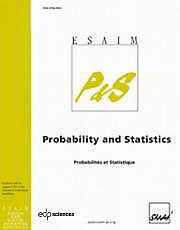Crossref Citations
This article has been cited by the following publications. This list is generated based on data provided by
Crossref.
Baricz, Árpád
2010.
Turán type inequalities for some probability density functions.
Studia Scientiarum Mathematicarum Hungarica,
Vol. 47,
Issue. 2,
p.
175.
Hillion, Erwan
2012.
Concavity of entropy along binomial convolutions.
Electronic Communications in Probability,
Vol. 17,
Issue. none,
Johnson, Oliver
Kontoyiannis, Ioannis
and
Madiman, Mokshay
2013.
Log-concavity, ultra-log-concavity, and a maximum entropy property of discrete compound Poisson measures.
Discrete Applied Mathematics,
Vol. 161,
Issue. 9,
p.
1232.
Sangüesa, Carmen
Badía, Francisco German
and
Cha, Ji Hwan
2014.
Preservation of ageing classes in deterioration models with independent increments.
Journal of Inequalities and Applications,
Vol. 2014,
Issue. 1,
Alimohammadi, Mahdi
Alamatsaz, Mohammad Hossein
and
Cramer, Erhard
2015.
Discrete strong unimodality of order statistics.
Statistics & Probability Letters,
Vol. 103,
Issue. ,
p.
176.
Barranco-Chamorro, I.
Moreno-Rebollo, J.L.
Jiménez-Gamero, M.D.
and
Alba-Fernández, M.V.
2015.
Estimation of the sample size n based on record values.
Mathematics and Computers in Simulation,
Vol. 118,
Issue. ,
p.
58.
Celik, Abdulkadir
and
Kamal, Ahmed E.
2016.
Multi-Objective Clustering Optimization for Multi-Channel Cooperative Spectrum Sensing in Heterogeneous Green CRNs.
IEEE Transactions on Cognitive Communications and Networking,
Vol. 2,
Issue. 2,
p.
150.
Medina, Luis A.
and
Straub, Armin
2016.
On Multiple and Infinite Log-Concavity.
Annals of Combinatorics,
Vol. 20,
Issue. 1,
p.
125.
Mao, Tiantian
Xia, Wanwan
and
Hu, Taizhong
2018.
PRESERVATION OF LOG-CONCAVITY UNDER CONVOLUTION.
Probability in the Engineering and Informational Sciences,
Vol. 32,
Issue. 4,
p.
567.
Krachun, D.
and
Yakubovich, Yu.
2018.
On Random Partitions Induced by Random Maps.
Journal of Mathematical Sciences,
Vol. 229,
Issue. 6,
p.
727.
Mazalov, Vladimir V.
and
Chirkova, Julia V.
2019.
Networking Games.
p.
211.
2019.
Networking Games.
p.
303.
Chirkova, Yu.V.
2020.
Optimal Arrivals in a Two-Server Rational Random-Access System with Loss.
Automation and Remote Control,
Vol. 81,
Issue. 7,
p.
1345.
Lawrence, Brian
and
Venkatesh, Akshay
2020.
Diophantine problems and p-adic period mappings.
Inventiones mathematicae,
Vol. 221,
Issue. 3,
p.
893.
Heim, Bernhard
and
Neuhauser, Markus
2021.
Polynomization of the Chern–Fu–Tang conjecture.
Research in Number Theory,
Vol. 7,
Issue. 2,
Bringmann, Kathrin
Kane, Ben
Rolen, Larry
and
Tripp, Zack
2021.
Fractional partitions and conjectures of Chern–Fu–Tang and Heim–Neuhauser.
Transactions of the American Mathematical Society, Series B,
Vol. 8,
Issue. 21,
p.
615.
Chen, Xi
He, Simai
Jiang, Bo
Ryan, Christopher Thomas
and
Zhang, Teng
2021.
The Discrete Moment Problem with Nonconvex Shape Constraints.
Operations Research,
Vol. 69,
Issue. 1,
p.
279.
Noh, Hyunmin
Park, Gi Seok
Go, Yunmin
and
Song, Hwangjun
2022.
HTTP Adaptive Streaming System Maximizing Overall Video Quality over SDN-enabled Wi-Fi APs.
p.
178.
Bobkov, Sergey G.
Marsiglietti, Arnaud
and
Melbourne, James
2022.
Concentration functions and entropy bounds for discrete log-concave distributions.
Combinatorics, Probability and Computing,
Vol. 31,
Issue. 1,
p.
54.
Malinovsky, Yaakov
and
Moon, John W.
2022.
On negative dependence inequalities and maximal scores in round-robin tournaments.
Statistics & Probability Letters,
Vol. 185,
Issue. ,
p.
109432.




